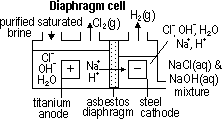| element | atomic # | elec config |
| fluorine | 9 | 1s22s22p5 |
| chlorine | 17 | [Ne]3s23p5 |
| bromine | 35 | [Ar]3d104s24p5 |
| iodine | 53 | [Kr]4d105s25p5 |
| element | colour | state at rtp | mp/°C | bp/°C |
| Cl2 | yellow-green | gas | -101 | -34.5 |
| Br2 | reddish brown | liquid | -72 | 58.8 |
| I2 | black | solid | 114 | 184 |
| halogen | ppt colour | photosensitive | reaction w/ aq NH3 |
| Cl | white | yes | aq NH3 > soluble: AgCl + 2NH3(aq) > Ag(NH3)2+(aq) + Cl- |
| Br | pale yellow/cream | yes | conc aq NH3 > soluble: AgBr + 2NH3(aq) > Ag(NH3)2+(aq) + Br- |
| I | yellow | no | insoluble |
